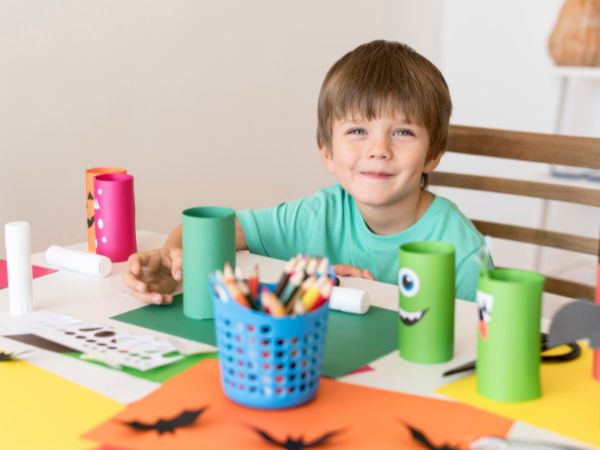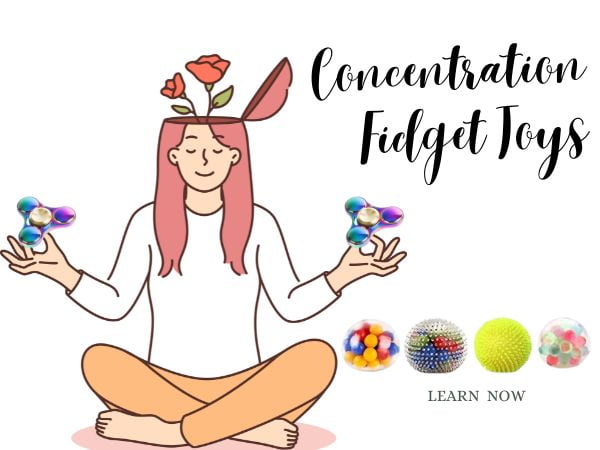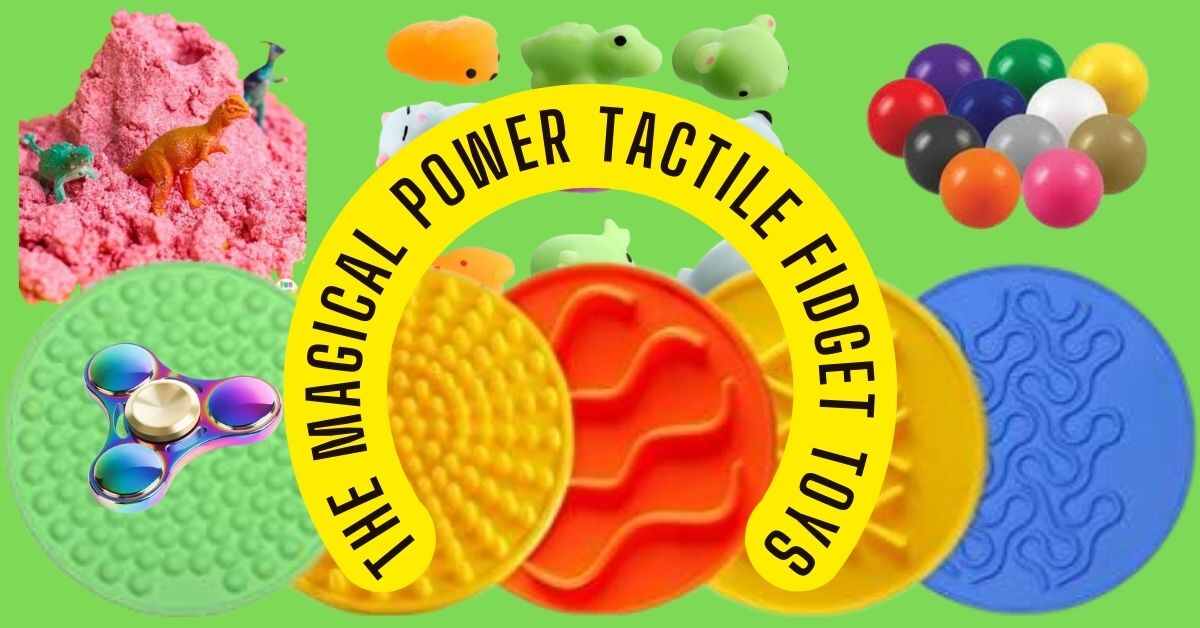I. Introduction
Stress and worry are ubiquitous in modern life, making it challenging to find quiet time. A tiny, portable device called the “Fidget Cube for Anxiety” calms restless energy and creates a mental sanctuary. These devices have developed into essential allies for people looking for comfort in the middle of life’s stress. The fidget cube has evolved into a symbol of hope, showing the way to a happier mental state.
Table of Contents
II. Understanding Anxiety
A. Explanation of anxiety disorders and their impact
- Anxiety Disorders Overview
- Generalized Anxiety Disorder (GAD): Excessive worry, fear, or apprehension, affecting daily life.
- Panic Disorder: Sudden, intense fear episodes, accompanied by symptoms like a racing heart, shortness of breath, sweating, and fear of impending doom.
- Social Anxiety Disorder (SAD): Intense fear of social situations and heightened self-consciousness in social interactions.
- Specific Phobias: Intense fear of a specific object, situation, or activity, often leading to extreme avoidance.
- Obsessive-Compulsive Disorder (OCD): Intrusive thoughts and repetitive behaviors to alleviate anxiety, often time-consuming and affecting daily functioning.
- Post-Traumatic Stress Disorder (PTSD): Develops after exposure to a traumatic event, causing flashbacks, nightmares, and severe anxiety.
- Impact of Anxiety Disorders
- Impairs daily functioning: Difficulty in completing tasks, maintaining relationships, and achieving goals.
- Physical health issues: Chronic anxiety can lead to cardiovascular issues, gastrointestinal disturbances, and weakened immune function.
- Isolation and social impairment: Social anxiety can lead to isolation and difficulty in forming and maintaining relationships.
- Impact on work and academic performance: Decreased productivity, absenteeism, or academic underachievement.
- Co-occurring conditions: Anxiety disorders often coexist with other mental health conditions like depression or substance abuse.
B. Connection between anxiety and the need for effective coping mechanisms
- Anxiety is a complicated mental illness that frequently results in excruciating levels of tension, concern, and terror.
- Anxiety management requires the use of efficient coping strategies, such as stress reduction, emotional regulation, cognitive restructuring, social support, good lifestyle choices, mindfulness, and professional assistance.
- Methods such as progressive muscular relaxation, mindfulness, and deep breathing can assist in lowering the body’s reaction to worry.
- Cognitive restructuring can assist people in challenging negative thought patterns linked to anxiety, such as in cognitive-behavioral treatment (CBT). Anxiety can be managed with the aid of social support, a healthy lifestyle, mindfulness, and professional assistance.
- Individuals can enhance their general well-being and overcome anxiety-inducing situations by developing and putting into practice particular behavioral methods.
III. Benefits of Fidget Cube for anxiety
A. Stress and anxiety reduction through fidgeting
- Calming Effect: By giving people a tactile and sensory release, fidget cubes can ease tension and calm people down. Moving in a rhythmic, repeated manner might help to calm the mind.
- Mindful Diversion: Shifting focus from stressful situations or unsettling thoughts can be achieved by fidgeting with a cube. Relaxation can be facilitated by taking a mental break and manipulating the cube physically.
- Fills Restless Energy: The purpose of fidget cubes is to satisfy the urge for tactile stimulation and movement. This can be especially helpful for people who have excessive energy or restlessness because it gives them a productive outlet.
B. Scientifically proven advantages of using fidget cube for anxiety
- Reduction of Stress Hormones: Research indicates that engaging in repetitive motion and tactile stimulation activities can result in a reduction of stress hormones, including cortisol. Fidget cubes offer a methodical approach to integrating these hobbies into everyday schedules.
- Improved Focus for Some People: Although this isn’t always the case, for some people having a non-disruptive way to fidget can help with focus and concentration. This can be especially important for tasks that call for prolonged focus.
- Benefits for the Brain: Fidgeting may activate specific brain regions, which may improve cognitive performance. It can be extremely beneficial for those who require some level of sensory input to be attentive and mentally sharp.
C. Comparison with other stress relief methods
| Specific Features and Advantages | Fidget Cubes | Other Methods (e.g., Stress Balls, Clicker Devices) |
| Non-disruptive in Shared Spaces | Fidget cubes are discreet and quiet, suitable for various environments without disruptions. | Some methods, like stress balls or clickers, may produce audible sounds, potentially causing disturbances in shared spaces. |
| Versatility | Fidget cubes offer a variety of features (buttons, switches, rollers), allowing users to engage based on personal preferences. | Other methods may have a more limited range of sensory input options, catering to specific preferences to a lesser extent. |
| Portable and Convenient | Fidget cubes are compact and easily portable, fitting in pockets or bags for on-the-go stress relief. | Other methods may vary in portability, with some being bulkier or less convenient for carrying in everyday situations. |
| Non-Consumable | Fidget cubes are reusable and do not require replenishing, offering a cost-effective and eco-friendly option. | Some stress relief methods involve consumables (e.g., chewing gum, snacks), leading to ongoing costs and potential environmental impact. |
IV. Types of Fidget Cubes
A. Overview of different designs and functionalities
Fidget cubes are compact, portable gadgets made to stimulate users’ senses, reduce tension and anxiety, and enhance concentration. To meet a range of demands and tastes, there are numerous styles and functionality available. Below is a summary of a few typical types:
1. Traditional Fidget Cube:
- It includes a variety of textures and surfaces.
- It usually consists of rolling balls, switches, and buttons.
- It gives a whole fidgeting sensation.
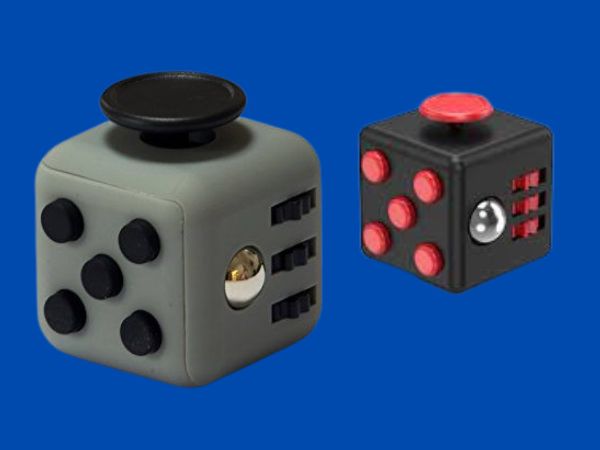
2. Device-Centered Cube:
- It includes components such as a joystick, clickable ball, and gears.
- Appealing to people who like the tactile aspect of mechanical devices.

3. Lumen Cube:
- It is fitted with additional visual components like LED lighting.
- It provides a visually engaging experience that is best suited for people who react favorably to visual cues.
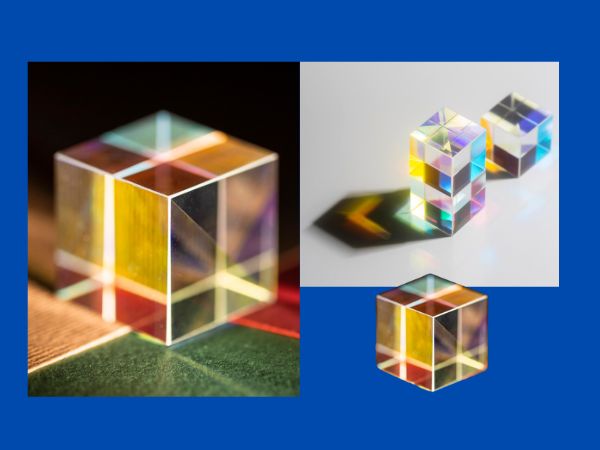
4. Quiet Fidget Cube:
- It is designed to allow for noiseless, covert fidgeting.
- It is appropriate for quiet areas because the switches and buttons are designed to be silent.
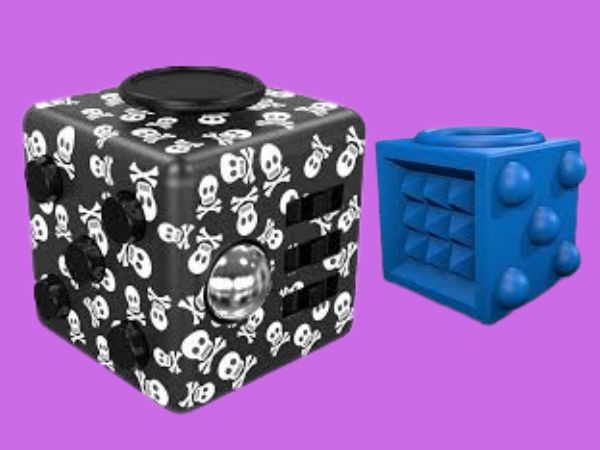
5. Adaptable Cube:
- It enables users to alter their cube or swap out alternative modules.
- It provides a customized experience for fidgeting.

B. Primary focus on cubes with various textures, buttons, and switches
- Textured Surfaces:
- Some cubes have surfaces with various textures such as bumps, ridges, or smooth areas.
- Appeals to users who enjoy tactile sensations.
- Clickable Buttons:
- Includes buttons that can be pressed or clicked.
- Mimics the satisfaction of pressing a button, providing auditory and tactile feedback.
- Switches and Toggles:
- Features switches and toggles that can be flipped or moved.
- Appeals to users who find satisfaction in repetitive motion.
- Rolling Balls:
- Incorporates rolling balls or gears for rolling and spinning motions.
- Provides a dynamic fidgeting experience.
V. How to Use Fidget Cubes Effectively
A. Incorporating fidgeting into daily routines
- Desk or Workspace:
- Keep a fidget cube on your desk or workspace to use during work or study sessions.
- Use it during breaks to refresh your mind and maintain focus.
- Travel Companion:
- Take a portable fidget cube with you when commuting or traveling.
- Use it during transit to alleviate stress and anxiety.
- Meetings or Classes:
- Discretely use a silent fidget cube during meetings or classes to help maintain attention and reduce restlessness.
- Mindful Fidgeting:
- Integrate fidgeting into mindfulness practices.
- Use the cube as a tool for grounding and staying present in the moment.
B. Techniques for maximizing stress relief benefits
- Deep Breathing Exercises:
- Combine fidgeting with deep breathing exercises for enhanced relaxation.
- Inhale deeply while engaging with the fidget cube, then exhale slowly to promote a sense of calm.
- Focused Fidgeting:
- Use the fidget cube intentionally to redirect restless energy.
- Engage with specific features mindfully, focusing on the tactile sensations
- Progressive Muscle Relaxation:
- Use the cube in conjunction with progressive muscle relaxation techniques.
- Tense and release muscles while fidgeting to promote overall relaxation.
- Stress Relief Rituals:
- Establish fidgeting as a stress relief ritual.
- Use the cube as a signal to your mind that it’s time to unwind and de-stress.
C. Success stories of individuals who integrated fidget cubes into their lives
- Improved Focus and Productivity:
- When fidget cubes are included in daily routines, people have reported better focus and productivity at work or in academic settings.
- Decreased Stress and Anxiety:
- Fidget cubes have been shown to help users feel less stressed and anxious in stressful situations or when faced with difficult tasks.
- Improved Coping Strategy:
- Fidget cubes have been effectively incorporated by some people as a coping strategy for anxiety disorders, ADHD, and other conditions.
- Positive Effect on Mental Health:
- Fidget cubes have received recognition for improving mental health and assisting users in reducing daily stress.
- Improved Relationships:
- Fidget cube use has been linked to improved interpersonal relationships among users, as it has been shown to lessen restlessness and impatience and promote more patient and focused conversations.
VI. Fidget Cube Reviews
A. Top Brands in the Market: A Comparative Analysis
- ZURU Fidget Cube:
- A well-known brand offering a variety of fidget cubes.
- Known for durable construction and multiple tactile features.
- Often praised for its effectiveness in stress relief.
- Antsy Labs Original Fidget Cube:
- One of the pioneers in the fidget cube market.
- Features various textures, buttons, and switches for diverse fidgeting experiences.
- Recognized for its quality and craftsmanship.
- Trianium Fidget Cube:
- It is well-liked for its portable and small size.
- Includes a range of tactile elements for effective fidgeting.
- Known for affordability without compromising quality.
- SCIONE Fidget Cube:
- Offers a budget-friendly option with a variety of features.
- Positive feedback for its durability and effectiveness in stress relief.
- Suitable for those seeking an affordable yet functional option.
- FIDGET DICE Fidget Cube:
- Features a unique dice design with multiple fidgeting elements.
- Compact and travel-friendly.
- Positive reviews for its engaging design and tactile feedback.
B. Customer Ratings and Feedback: Unbiased Perspectives
1. Zen Cube Pro
“The Zen Cube Pro is a game-changer! The smooth rotations and satisfying clicks make it the perfect stress reliever. The high-quality materials and durable construction ensure long-lasting enjoyment. Worth the investment for anyone looking to stay focused and calm throughout the day.
Rating: ⭐⭐⭐⭐⭐ (5/5 stars)

2. Fidget Master Infinity Cube
The Fidget Master Infinity Cube is a solid choice for fidget enthusiasts. The interlocking design provides endless fidgeting possibilities. It’s pocket-sized and great for on-the-go. My only gripe is that it can be a bit noisy in quiet environments, but overall, a fantastic stress-relief tool.
Rating: ⭐⭐⭐⭐ (4/5 stars)

3. Serenity Sphere Fidget Spinner Cube
The Serenity Sphere Fidget Spinner Cube has a unique design, but I found it a bit challenging to use. The spinning motion is smooth, but the cube’s edges are a bit sharp, making it uncomfortable for extended use. It’s an okay option if you’re looking for something different, but not my top choice.
Rating: ⭐⭐⭐ (3/5 stars)
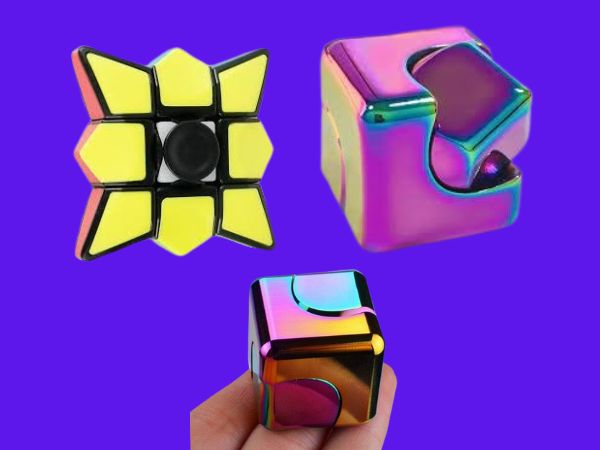
4. Focus Flicker Ultimate Fidget Cube
The Focus Flicker Ultimate Fidget Cube is a must-have for anyone dealing with stress or anxiety. The various textures and satisfying clicks keep your hands busy and your mind focused. The compact size is perfect for discreet fidgeting during meetings or classes. Highly recommended.
Rating: ⭐⭐⭐⭐⭐ (5/5 stars)

5. Relax Ridge Multi-Sensory Cube
The Relax Ridge Multi-Sensory Cube is a great tool for fidgeting, with its different textures and features. The build quality is good, and it provides a nice tactile experience. However, some may find it a bit bulky for everyday pocket carry. Still, it’s effective in promoting relaxation and concentration.
Rating: ⭐⭐⭐⭐ (4/5 stars)

VII. Choosing the Perfect Fidget Cube
A. Personal Preferences: Matching Features to Needs
- Tactile Elements:
- Identify the specific tactile features you enjoy, such as buttons, switches, textures, or rolling elements.
- Choose a fidget cube that aligns with your preferred sensory experiences.
- Size and Shape:
- Consider the size and shape that feel comfortable in your hand.
- Some may prefer a compact design for portability, while others may prefer a larger cube with more features.
- Visual Appeal:
- Some fidget cubes come with unique designs or color options.
- If aesthetics matter to you, choose a cube that visually resonates with your preferences.
- Customization Options:
- Determine if you prefer a standard design or if you’d like a fidget cube with customizable elements.
- Some cubes allow users to swap out modules for a personalized experience.
B. Factors to Consider: Noise Level, Portability, and Durability
- Noise Level:
- Consider the environment in which you’ll be using the fidget cube.
- If you need a quiet option, look for cubes designed to minimize noise, especially if you plan to use it in a shared or quiet setting.
- Portability:
- Assess how and where you plan to use the fidget cube.
- Opt for a compact and travel-friendly design if you need to carry it with you throughout the day.
- Durability:
- Check customer reviews and product descriptions for information on the durability of the fidget cube.
- Ensure that it’s made from quality materials to withstand regular use.
- Functionality:
- Consider the variety of features and functionalities offered by the cube.
- Choose a cube with elements that address your specific fidgeting habits and preferences.
C. Finding Your Zen: A Buyer’s Guide
- Research Brands:
- Explore reputable brands in the market and read reviews to gauge their reliability.
- Look for brands known for quality construction and positive customer feedback.
- Customer Reviews:
- Read customer reviews on e-commerce platforms to get insights into real-world experiences.
- Pay attention to feedback related to features, durability, and overall satisfaction.
- Trial and Error:
- If possible, try out different fidget cubes to see which one feels most comfortable and enjoyable for you.
- Understand that individual preferences vary, and what works for one person may not work for another.
- Budget Considerations:
- Determine your budget and explore options within that range.
- Balance affordability with quality to ensure you get the best value for your investment.
- Return Policies:
- Check the return policies of the seller or manufacturer.
- Having the option to return or exchange the fidget cube if it doesn’t meet your expectations provides added peace of mind.
VIII. Addressing Common Concerns
A. Debunking Myths Surrounding Fidgeting
- Fidgeting Equals Distraction:
- Myth: Fidgeting is often perceived as a sign of distraction or lack of focus.
- Reality: For many individuals, controlled fidgeting can enhance concentration and help manage restlessness.
- Disruption in Learning Environments:
- Myth: Fidgeting in classrooms or workspaces may disrupt others.
- Reality: Silent or discreet fidgeting tools, like fidget cubes, are designed to minimize noise and disturbance.
- Fidgeting Is Impolite:
- Myth: Fidgeting is considered impolite or disrespectful in social settings.
- Reality: Fidgeting discreetly with tools like fidget cubes is generally accepted and understood as a coping mechanism for stress or anxiety.
B. Addressing Potential Drawbacks and How to Overcome Them
- Noise Concerns:
- Drawback: Some fidget tools may produce noise, potentially causing disturbance.
- Overcoming: Choose fidget cubes designed to be silent, ensuring minimal disruption in quiet environments.
- Overdependence on Fidgeting:
- Drawback: There’s a concern that individuals may become overly reliant on fidgeting tools.
- Overcoming: Use fidget cubes as one part of a holistic approach to stress management. Incorporate other techniques like mindfulness and breaks.
- Ineffective in Certain Situations:
- Drawback: Fidgeting may not be suitable for every situation or individual.
- Overcoming: Assess the appropriateness of fidgeting based on the context and individual preferences. Respect workplace or classroom rules regarding fidgeting.
- Potential Distraction for Others:
- Drawback: Visible or noisy fidgeting may distract others.
- Overcoming: Choose fidget tools that are discreet, silent, and can be used without drawing attention. Communicate with colleagues or peers about your fidgeting habit and find a middle ground.
C. Expert Opinions on the Efficacy of Fidget Cubes
- Supportive Research:
- Some studies suggest that fidgeting can have positive effects on focus and cognitive performance. However, more research is needed.
- Individual Variability:
- Experts recognize that the effectiveness of fidget cubes varies among individuals.
- It is essential to consider personal preferences and needs when evaluating the impact of fidgeting tools.
- Incorporating Mindfulness:
- Some experts recommend combining fidgeting with mindfulness practices for a more comprehensive approach to stress relief.
- Mindful fidgeting involves staying present in the moment while engaging with the fidget tool.
- Consideration of Context:
- Experts emphasize the importance of considering the context in which fidgeting occurs.
- Fidgeting may be more acceptable in certain environments, and individuals should be mindful of others’ comfort.
IX. DIY Fidget Cube Ideas
A. Creative Ways to Make Homemade Fidget Cubes
- Beaded Fidget Cube:
- String different-sized beads on elastic cords and attach them to each side of a small cube.
- Users can roll the beads, creating a tactile and visual fidgeting experience.
- Rubber Band Cube:
- Wrap rubber bands around a small cube, creating a textured surface.
- Stretch and manipulate the rubber bands for a satisfying tactile sensation.
- Texture Patchwork Cube:
- Cover each face of a cube with different textured materials like sandpaper, fabric, or foam.
- Provides a variety of tactile sensations for users.
- Button and Marble Cube:
- Glue small buttons or marbles onto each side of the cube.
- Pressing the buttons or rolling the marbles can offer a satisfying fidgeting experience.
- Lego Fidget Cube:
- Attach different Lego pieces to each side of a cube.
- Users can click, spin, and detach the Lego elements for an engaging fidgeting experience.
B. Materials and Step-by-Step Guides for DIY Enthusiasts
- Materials:
- Small wooden or plastic cubes
- Beads, rubber bands, buttons, marbles, or other textured materials
- Glue or adhesive
- Elastic cords (for beaded cubes)
- Lego pieces (for Lego cubes)
- Step-by-Step Guide:
- Select a small cube as the base for your fidget cube.
- Choose materials based on your preferences for tactile sensations.
- Adhere the materials to each face of the cube using glue or adhesive.
- Ensure that the materials are securely attached and won’t pose a choking hazard.
- For beaded cubes, string beads onto elastic cords and attach them to the cube’s sides.
- Allow the cube to dry completely before use.
- Safety Considerations:
- Ensure that the materials used are safe and won’t cause harm, especially if the fidget cube is intended for children.
- Avoid small, detachable parts that could pose a choking hazard.
C. Encouraging Personalization for Enhanced Stress Relief
- Colorful Personalization:
- Paint or decorate the cube in colors that evoke a sense of calm or joy for you.
- Personalizing the appearance can add a visual element to the stress relief experience.
- Incorporate Personal Items:
- Attach small items with personal significance, such as small photos or charms.
- This personal touch can make the fidget cube more meaningful and comforting.
- Scented Additions:
- Add scented elements like essential oil-infused materials or sachets.
- Engaging the sense of smell can enhance the overall stress-relief experience.
- Customizable Modules:
- Create modular sections that can be swapped out or rearranged based on your preferences.
- This allows for a dynamic and personalized fidgeting experience.
- Personalized Labels:
- Add labels or symbols to each side of the cube, indicating the type of texture or feature on that face.
- This can help you remember and engage with specific elements during fidgeting.
X. Fidget Cubes and Mental Health
A. Professional Opinions on the Role of Fidgeting in Mental Health
- Occupational Therapists:
- Occupational therapists often recommend fidget tools as part of sensory strategies to address sensory processing challenges.
- Fidgeting can be seen as a self-regulation technique to help individuals maintain focus and manage stress.
- Psychologists and Counselors:
- Some psychologists and counselors acknowledge the potential benefits of fidgeting in relieving anxiety and stress.
- Controlled fidgeting may serve as a coping mechanism, providing a physical outlet for emotional tension.
- ADHD Experts:
- Experts in ADHD treatment recognize fidgeting as a common behavior in individuals with ADHD.
- Fidget tools, including fidget cubes, are often recommended to help individuals channel excess energy and improve focus.
B. Success Stories from Mental Health Experts and Professionals
- Improved Focus in Therapy:
- Mental health professionals have reported that allowing clients to use fidget cubes during therapy sessions can enhance focus and engagement.
- Clients may find it easier to open up and express themselves when they have a subtle outlet for nervous energy.
- Stress Reduction in Anxiety Treatment:
- Anxiety treatment programs sometimes incorporate fidget tools to help individuals manage stress.
- Fidget cubes provide a discreet way to address anxiety symptoms, allowing users to fidget without drawing attention to themselves.
- Positive Impact on Coping Skills:
- Mental health experts have observed the positive impact of fidget cubes in teaching and reinforcing healthy coping skills.
- Using fidget tools can become a healthy habit for managing stress and promoting emotional well-being.
C. The Future of Fidgeting as a Mainstream Mental Health Tool
- Integration into Therapy Practices:
- Some therapists are increasingly incorporating fidget tools into their practices, recognizing their potential as aids in mental health treatment.
- Fidgeting may become a more widely accepted and integrated aspect of therapy sessions.
- Research and Validation:
- Ongoing research on the efficacy of fidgeting tools in mental health settings may contribute to their mainstream acceptance.
- As more studies validate the benefits, fidgeting tools could become recognized as valuable additions to mental health interventions.
- Incorporation into Wellness Programs:
- Wellness programs and workplaces may incorporate fidgeting as a proactive approach to mental health.
- Fidget tools like cubes could become common features in stress management programs.
- Diverse Range of Tools:
- The future may bring a broader range of fidget tools tailored to specific mental health needs.
- Different designs and functionalities could cater to individuals with various sensory preferences.
XI. Future Innovations in Fidget Cubes
A. Tech Integration: Smart Fidgeting for the Digital Age
- Bluetooth Connectivity:
- Future fidget cubes could integrate with smartphones or other devices via Bluetooth.
- Users may be able to track their fidgeting habits, set goals, and receive notifications for breaks.
- Sensor Technology:
- Advanced sensor technology could be incorporated to provide real-time feedback on fidgeting patterns.
- Users might receive insights into their stress levels and optimal times for fidgeting.
- App Compatibility:
- Fidget cubes may come with dedicated mobile apps that offer additional features and customization options.
- Apps could provide guided fidgeting exercises, mindfulness sessions, or analytics on fidgeting trends.
- Haptic Feedback:
- Smart fidget cubes might include haptic feedback mechanisms, enhancing the tactile experience.
- Users could feel subtle vibrations or sensations as they interact with the cube.
B. Sustainability in Fidgeting: Eco-Friendly Cube Designs
- Biodegradable Materials:
- Future fidget cubes may prioritize the use of biodegradable and eco-friendly materials.
- This aligns with the growing demand for sustainable and environmentally conscious products.
- Recycled Components:
- Fidget cubes could be designed using recycled materials, contributing to the reduction of waste.
- Sustainable manufacturing practices may become a key focus for fidget cube producers.
- Minimalist and Durable Design:
- Sustainable fidget cubes may feature minimalist designs that prioritize durability.
- Long-lasting materials and construction could reduce the need for frequent replacements.
- Reusable Packaging:
- Companies may adopt reusable or recyclable packaging for fidget cubes.
- The emphasis on sustainability may extend to the entire product lifecycle, from manufacturing to disposal.
C. The Evolution of Fidget Cubes: Predictions and Speculations
- Modular and Customizable Cubes:
- Fidget cubes of the future might embrace modular designs, allowing users to swap out or customize individual components.
- Users could personalize their fidgeting experience by selecting specific textures, buttons, or switches.
- Integration with Augmented Reality (AR):
- Augmented reality features could be incorporated into fidget cubes, creating interactive and immersive fidgeting experiences.
- Users may engage with virtual elements overlaid onto the physical cube.
- Ergonomic Designs:
- Future fidget cubes may prioritize ergonomic designs that cater to diverse hand sizes and preferences.
- Comfort and usability may become key considerations in design innovation.
- Cross-Industry Collaborations:
- Collaborations between fidget cube manufacturers and other industries (such as gaming or tech) may lead to innovative features and designs.
- Integration with popular franchises or characters could also become a trend.
- Cultural and Artistic Influences:
- Fidget cube designs may draw inspiration from cultural and artistic influences, creating unique and aesthetically pleasing products.
- Limited-edition releases featuring collaborations with artists or designers could become more common
XII. Conclusion
Fidget cubes are effective aids for stress and anxiety management. Their tactile qualities encourage relaxation and concentration by offering a covert and efficient release of tense energy. Fidget cubes provide consumers with a concrete way to deal with the difficulties of everyday life, whether it’s by the calming feel of a surface or the gratifying click of a button.
It is clear from addressing typical issues, dispelling myths, and investigating the possibilities for individualized and tech-integrated improvements that these little devices can significantly enhance mental health.
XIII. FAQs
Q1: What exactly is a fidget cube, and how does it help with anxiety?
A fidget cube is a small handheld device designed to provide sensory stimulation through various textures and features. It helps manage anxiety by offering a tactile outlet, promoting focus, and reducing stress through repetitive motions.
Q2: Are fidget cubes only suitable for individuals with diagnosed anxiety disorders?
Not at all! Fidget cubes are beneficial for anyone dealing with stress or seeking to improve focus. They’re versatile tools that can be used by students, professionals, or anyone looking for a simple stress-relief solution.
Q3: How do I choose the right fidget cube for my needs?
Consider factors such as texture preferences, functionality (buttons, switches), and noise level. Our buyer’s guide in Section VII provides detailed insights into choosing the perfect fidget cube based on your personal preferences.
Q4: Are there DIY options for fidget cubes?
Yes, Section VIII provides creative DIY fidget cube ideas for those who enjoy a hands-on approach. It includes materials, and step-by-step guides, and encourages personalization for enhanced stress relief.
Q5: Do fidget cubes have a positive impact on mental health, beyond anxiety?
Section X explores the multifaceted benefits, including enhanced focus, and concentration, and their potential role in mental health.
Do Fidget Cubes have any side effects?
Generally, Fidget Cubes have no harmful side effects. However, it’s essential to use them mindfully to avoid distraction.
Disclaimer:
This article’s content is solely intended for general informative purposes. It should not be interpreted as professional advice as it is not intended to be such.
Those looking for guidance or treatment for anxiety disorders or other similar issues should speak with licensed medical professionals or mental health specialists. Fidget Cubes and other stress-relieving devices should be used responsibly; users are advised to evaluate their individual requirements and preferences.


